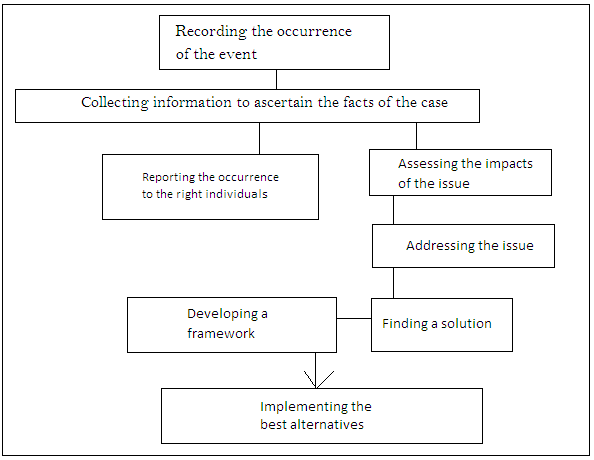Healthcare institutions should deal with ethical dilemmas using the best approaches. The targeted facility has a supervisor who monitors every ethical issue. The institution encourages its workers to focus on the best actions. The important goal is delivering quality care to targeted patients. The institution has a supervisor who “supports the wishes of different parties whenever there is an ethical problem” (Casterle, Izumi, Godfrey, & Denhaerynck, 2008, p. 543). Some malpractices in healthcare can result in legal issues. That being the case, healthcare facilities should use the best strategies in order to deal with every ethical issue.
Steps Taken whenever there are Ethical and Legal Dilemmas
The interviewee outlined the major strategies used to handle ethical dilemmas in the healthcare facility. The presented flowchart summarizes the actions undertaken by the organization whenever there is an ethical dilemma. The first step is recording the occurrence of the targeted event. Nurses and patients are encouraged to provide the required information. This information is “recorded in the Incident Report Form” (Furlong, 2012, p. 2). Nurses should also report every incident to the supervisor. The supervisor will be required to assess the impact of the ethical or legal dilemma. The supervisor is expected to address the issue using the best measures. The legal department (LG) provides the best suggestions. Throughout these steps, different stakeholders, such as relatives, caregivers, and patients, are required to provide their ideas. The important goal is to find the best solution to every dilemma.

Such ethical issues can “result in a court case” (Furlong, 2012, p. 6). However, the facility embraces appropriate measures in order to deal with every ethical dilemma. Every dilemma is taken seriously in order to develop a framework for future decision-making. The supervisor also communicates with different caregivers in order to deal with every avoidable ethical issue. The institution has formulated powerful frameworks that can address various ethical problems. The ethical issues experienced in the facility have reduced significantly within the past few years. The institution also focuses on the best decision-making processes in order to avoid the issues associated with court cases. Such practices continue to support the health needs of many stakeholders.
The Impact of Using the Court to Settle Ethical Dilemmas in Health Care
Furlong (2012) argues that “medical errors, malpractices, and ignorance in healthcare can result in court cases” (p. 4). Many patients prefer the use of courts to settle various ethical dilemmas. It is agreeable that courts protect the rights of many patients. However, such courts can affect the quality of care available to different communities. The use of courts to settle various ethical dilemmas can affect the morale of many nurse practitioners (NPs). Such NPs will eventually quit their jobs. This development explains why the number of healthcare providers in many countries has decreased significantly. The process can also be erroneous. This fact explains why many hospitals do not use courts to settle their ethical dilemmas.
The process also takes long, thus affecting the performance of many caregivers. The process also “affects the employability of many Nurse Practitioners” (Casterle et al., 2008, p. 542). Hospitals engaged in such court cases lose most of their clients. Medical facilities should, therefore, use effective action steps in order to deal with various ethical dilemmas. Courts “should be used as last options whenever dealing with various legal problems in healthcare” (Furlong, 2012, p. 7). Such steps will empower more caregivers and eventually produce the best health outcomes.
Reference List
Casterle, B., Izumi, S., Godfrey, N., & Denhaerynck, G. (2008). Nurses’ Responses to Ethical Dilemmas in Nursing Practice: Meta-Analysis. Journal of Advanced Nursing, 63(6), 540-549. Web.
Furlong, E. (2012). Right or Wrong: Legal and Ethical Issues and Decision-Making. Web.